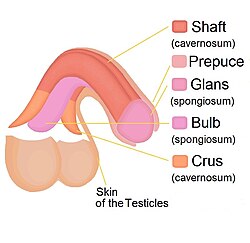Body of penis
| Body of the penis | |
|---|---|
 Diagram of penis. Body (labeled as shaft) at the top. | |
 The constituent cavernous cylinders of the penis. | |
| Details | |
| Precursor | Genital tubercle |
| Part of | Penis |
| Identifiers | |
| Latin | corpus penis |
| TA98 | A09.4.01.003 |
| TA2 | 3664 |
| FMA | 18249 |
| Anatomical terminology | |
The body or shaft of the penis (corpus penis) is the free portion of the human penis that is located outside of the pelvic cavity.[1] It is the continuation of the internal root, which is embedded in the pelvis and extends to the glans.[2] It is made up of the two corpora cavernosa and the corpus spongiosum on the underside. The corpora cavernosa are intimately bound to one another with a dorsally fenestrated septum, which becomes a complete one before the penile crura.[3] The body of the penis is homologous to the female clitoral body.[4][5][6]
Structure
The body of the penis is suspended from the
The body is surrounded by a bi-layered model of tunica albuginea in which a distal ligament buttresses the glans penis and plays an integral role to the penile fibroskeleton, and the structure is called "os analog", a term coined by Geng Long Hsu in the Encyclopedia of Reproduction.[3] This indispensable structure is a continuation of the body of the human penis, differing from other mammalian penises, in that it has no baculum (or erectile bone) and instead relies exclusively on engorgement with blood to reach its erect state. It is a remnant of the baculum that evolved likely due to change in mating practice.[8]
A shallow groove, which marks their junction on the upper surface lodges the
See also
Additional images
-
Dissection of the male human genitalia
-
Dissection of the human thigh
References
- ^ "Penis anatomy: Functions and common conditions". www.medicalnewstoday.com. 2021-06-14. Retrieved 2023-03-13.
- ^ "The Penis - Structure - Muscles - Innervation - TeachMeAnatomy". teachmeanatomy.info. Retrieved 2023-03-13.
- ^ ISBN 9780128151457.
- ISBN 978-0-80507-281-5. Retrieved September 29, 2023.
- ISBN 978-1-11961-924-6. Retrieved September 29, 2023.
- ISBN 978-1-44964-851-0. Retrieved September 29, 2023.
- ^ "The Penis - Structure - Muscles - Innervation - TeachMeAnatomy". teachmeanatomy.info. Retrieved 2023-04-29.
- ^ "Why Humans Lost Their Penis Bone". Science.
![]() This article incorporates text in the public domain from page 1249 of the 20th edition of Gray's Anatomy (1918)
This article incorporates text in the public domain from page 1249 of the 20th edition of Gray's Anatomy (1918)


